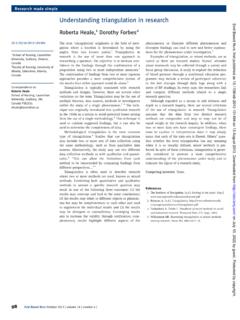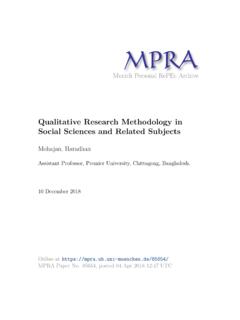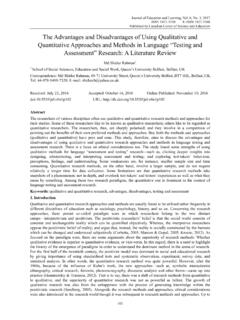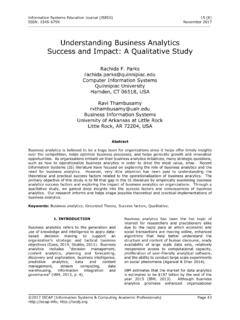Transcription of Validity, Reliability and Triangulation in Case Study ...
1 _____ *Corresponding author. Tel.: +60-019-3227479; Fax: +60-09-4552006 E-mail: 2016 The Authors qualitative Research Conference (QRC) 2016 24-26 May 2016, Penang, Malaysia validity , Reliability and Triangulation in Case Study Method: An Experience Zeittey Karmilla Kamana*, Zaleha Othmanb aSenior Lecturer, Universiti Tenaga Nasional, Kampus Sultan Haji Ahmad Shah, Pahang, Malaysia bSenior Lecturer,Universiti Utara Malaysia, Malaysia Abstract This article discusses the use of Reliability and validity in the qualitative research paradigm specifically in case Study method. First, Reliability , validity and Triangulation as used in case Study method are discussed as a way of providing a springboard to examining what these three terms mean. Secondly, the process of validity and Reliability in case Study method are discussed and how they can be employed in the qualitative research paradigm. This paper concludes by drawing upon the use of Triangulation in the two activities (data collection and case Study process) to show how the adoption have influenced our understanding of Reliability , validity and Triangulation in qualitative studies.
2 Keywords: validity , Reliability , Triangulation , case Study 1. INTRODUCTION validity and Reliability term has always probe a big question mark for qualitative researcher. The consistency, genuineness and trustworthiness of data in research has been queried in order to reflect the multiple ways of establishing truth. Therefore, the credibility of a qualitative research depends on the; i) validity and Reliability of research findings while designing a Study , analyzing results and judging the quality of the Study (Patton, 2001); ii) how far research findings of an inquiry are worth paying attention to the audience (Lincoln & Guba, 1985); iii) the quality of a Study in each paradigm should be judged by its own paradigm's terms for example credibility , neutrality or confirmability , consistency or dependability and applicability or transferability (Lincoln & Guba, 1985); iv) three principles of data collection were employed to make sure that the data collected were reliable and valid, hence lending credibility to the case Study such as: (a) multiple sources of data/evidence; (b) creating a database; and (c) maintaining a chain of evidence (Yin, 2009).
3 V) whether the researcher have fulfilling the rigor and thoroughness requirements in case Study process on (a) construct validity , (b) internal validity , (c) external validity and (d) Reliability (Yin, 1994); vi) ability and effort of the researcher (Golafshani, 2003) as the primary instrument in research (Merriam, 1988 and Patton, 2001) and vii) Triangulation as strategy (test) for enhancing the validity and Reliability of research or assessment of results (Mathison (1988) where researchers seeks for convergence among numerous and distinct sources of information to form themes or categories in a Study (Creswell & Miller, 2000, p. 126). In all, the purpose of this Study is to share the researcher experience on validity and Reliability in case Study method and how Triangulation has increase the trustworthiness and dependability of research findings. 2. LITERATURE REVIEW What is case Study research? Case Study research is defined as an empirical inquiry that investigates a contemporary phenomenon in depth and within its real-life context, especially when the boundaries between phenomenon and context is not clearly evident (Yin 2009, p.
4 18). Anderson (1993) sees case studies as being concerned with how and why things happen, allowing the investigation of contextual realities and the differences between what was planned and what Proceedings of the 2nd UUM International qualitative RESEARCH CONFERENCE 2016 24-26 May 2016. Penang, Malaysia Available online at 351 actually occurred. Case Study is not intended as a Study of the entire organization. Rather is intended to focus on a particular issue, feature or unit of analysis. In order to understand and examine the processes of training activities in organizations, case Study method was chosen. This method enables me to understand the complex real-life activities in which multiple sources of evidence were used. The used of case Study to probe an area of interest in depth is particularly appropriate as described by Patton (1987), that case studies become particularly useful where one needs to understand some particular problem or situation in great-depth, and where one can identify cases rich in information.
5 Reliability and validity in case Study research Although the term Reliability is a concept used for testing or evaluating quantitative research, the idea is most often used in all kinds of research. The most important test/strategy of any qualitative Study is its quality. A good qualitative Study can help us understand a situation that would otherwise be enigmatic or confusing (Eisner, 1991, p. 58). On the other hand, Patton (2001) states that validity and Reliability are two factors which any qualitative researcher should be concerned about while designing a Study , analyzing results and judging the quality of the Study . This corresponds to the question that How can an inquirer persuade his or her audiences that the research findings of an inquiry are worth paying attention to?" (Lincoln & Guba, 1985, p. 290). To answer to the question, Healy and Perry (2000) assert that the quality of a Study in each paradigm should be judged by its own paradigm's terms.
6 For example, while the terms Reliability and validity are essential criterion for quality in quantitative paradigms, in qualitative paradigms the terms Credibility, Neutrality or Confirmability, Consistency or Dependability and Applicability or Transferability are to be the essential criteria for quality (Lincoln & Guba, 1985). The concept of validity is described by a wide range of terms in qualitative studies. This concept is not a single, fixed or universal concept, but rather a contingent construct, inescapably grounded in the processes and intentions of particular research methodologies and projects (Winter, 2000, ). Additionally, Lincoln and Guba (1985) states that: "Since there can be no validity without Reliability , a demonstration of the former [ validity ] is sufficient to establish the latter [ Reliability ;]" (p. 316). Patton (2001) with regards to the researcher's ability and skill in any qualitative research also states that Reliability is a consequence of the validity in a Study .
7 Yin (2009) proposed three (3) principles of data collection to deal with the problems of establishing the construct validity and Reliability of the case Study evidence which are; (1) multiple sources of evidence; (2) create a case Study database; and (3) maintain a chain of evidence. With regards to rigour and thoroughness in case Study process, the elements of construct validity , internal validity , external validity and Reliability is the strategy used to enhance the validity and Reliability issue (Yin, 1994, 2009, 2012). Triangulation in case Study Triangulation is defined to be a validity procedure where researchers search for convergence among multiple and different sources of information to form themes or categories in a Study (Creswell & Miller, 2000, p. 126). Triangulation is typically a strategy (test) for improving the validity and Reliability of research or evaluation of findings. Mathison (1988) elaborates this by saying: Triangulation has risen an important methodological issue in naturalistic and qualitative approaches to evaluation [in order to] control bias and establishing valid propositions because traditional scientific techniques are incompatible with this alternate epistemology (p.)
8 13). Engaging multiple methods, such as, observation, interviews and documents review (Yin, 1994, 2009) will lead to more valid, reliable and diverse construction of realities. To improve the analysis and understanding of construction of others, Triangulation is a step taken by researchers to involve several investigators or peer researchers interpretation of the data at different time or location. In a related way, a qualitative researcher can use investigator Triangulation and consider the ideas and explanations generated by additional researchers studying the research participants (Johnson, 1997, ). Triangulation may include multiple methods of data collection and data analysis, but does not suggest a fix method for all the researches. The methods chosen in Triangulation to test the validity and Reliability of a Study depend on the criterion of the research (Golafshani, 2003). Patton (2002) discusses four types of triangulations in doing evaluations, data Triangulation , investigator Triangulation , theory Triangulation and methodological Triangulation .
9 Proceedings of the 2nd UUM International qualitative RESEARCH CONFERENCE 2016 24-26 May 2016. Penang, Malaysia Available online at 352 Yin (2009) advocates that Triangulation in case Study method have a major strength for example, the researcher have the opportunity to use many different sources of evidence in data collection. Furthermore, the need to use multiple sources of evidence far exceeds that in other research methods, such as experiments, surveys, or histories. 3. METHOD A single case Study was conducted in one of the leading petrochemical companies in Malaysia. A pseudonym is used to describe the company, which is referred to as Company A . The company is a petrochemical plant in nature. Company A and group-wide established a big conglomerate of chemical producer in Malaysia. The business activities include (i) the exploration, development and production of the refining and marketing of petroleum products; (ii) the manufacture and sale of petrochemical products; (iii) the trading of crude oil, natural gas, LNG, petroleum products and petrochemical products; and (iv) shipping and logistics relating to LNG, crude oil and petroleum products.
10 As the leading integrated chemical producer in Malaysia with a total combined production capacity of over 10 million metric tons per annum (mtpa), Company A and the group-wide entity involve primarily in manufacturing, marketing and selling a diversified range of chemical products, including ammonia commercially, as well as supplying carbon monoxide (CO) and oxogas (a mixture of hydrogen and CO), olefins, polymers, fertilizers, methanol and other basic chemicals and derivative products. Company A was chosen as a case to be studied in the present research for five reasons, discussed below: (i) First, a single case can contribute significantly contribution to knowledge and theory building (the Study was conducted on how company A implemented its corporate social responsibility (CSR) towards environmental protection in Malaysia). (ii) Secondly, Company A was chosen because the case represented an extreme or unique case.





